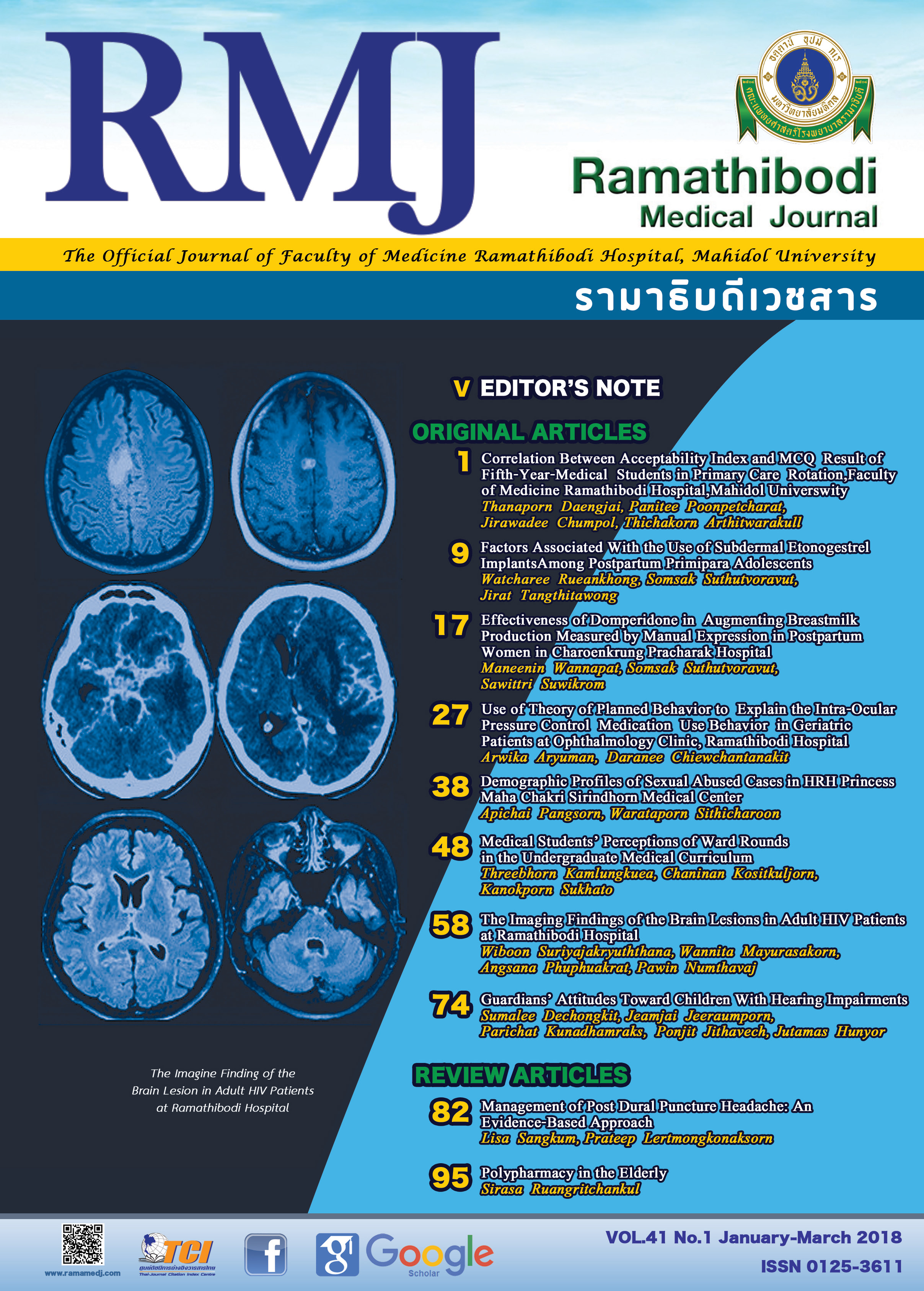Use of Theory of Planned Behavior to Explain the Intra-Ocular Pressure Control Medication Use Behavior in Geriatric Patients at Ophthalmology Clinic, Ramathibodi Hospital
DOI:
https://doi.org/10.14456/rmj.2018.4Keywords:
Theory of planned behavior, Intra-ocular pressure control medication, GlaucomaAbstract
Background: Treatment of glaucoma with intra-ocular pressure control medication is important to maintain consistency. Noncompliance with drug use is a major problem affecting achievement in the treatment with glaucoma drugs.
Objective: To identify factors that are associated with intra-ocular pressure control medication use behavior in geriatric patients of ophthalmology clinic at Ramathibodi Hospital.
Methods: This research was cross-sectional descriptive study. Three hundred seventy-five elderly patients with glaucoma who received services in ophthalmology clinic were enrolled in this study. Questionnaires were created based on the theory of planned behavior. Correlation analysis using the Spearman rank correlation coefficient.
Results: Factors correlated with intentions to use intra-ocular pressure control medication were gender (r = 0.11) income (r = -0.13) duration of disease (r = 0.19) attitudes toward behavior (r = 0.23) and perceived behavioral control (r = 0.15). Factors correlated with the intra-ocular pressure control medication use behavior were income (r = 0.16) attendant (r = -0.118) attitudes toward behavior (r = 0.18) perceived behavioral control (r = 0.15) and intentions to use medication (r = 0.31).
Conclusions: Healthcare providers may use these factors as a guide in behavioral modification procedure to control the intraocular pressure by use intra-ocular Pressure control medication and other special techniques medication. Understanding the reasons for nonadherence and designing better interventions to improve medication adherence in glaucoma patients and a worthy goal of treatment is patients derive the maximal benefit of therapies.
References
Quigley HA, Broman AT. The number of people with glaucoma worldwide in 2010 and 2020. Br J Ophthalmol. 2006;90(3):262-267. doi:10.1136/bjo.2005.081224.
Tham YC, Li X, Wong TY, Quigley HA, Aung T, Cheng CY. Global prevalence of glaucoma and projections of glaucoma burden through 2040: a systematic review and meta-analysis. Ophthalmology. 2014;121(11):2081-2090. doi:10.1016/j.ophtha.2014.05.013.
Glaucoma.org. Glaucoma Research Foundation. https://www.glaucoma.org/glaucoma/glaucoma-facts-and-stats.php. Updated May 5, 2015. Accessed January 16, 2018.
Ruksanit D. Factors associated with intra-ocular pressure control, primary glaucoma patients at out patient department of Phramongkutklao Hospital. Journal of The Royal Thai Army Nurses. 2015;16(1):109-115. https://www.tci-thaijo.org/index.php/JRTAN/article/view/36166. Accessed January 26, 2018.
Cho HK, Kee C. Population-based glaucoma prevalence studies in Asians. Sur Ophthalmol. 2014;59(4):434-447.
Maier PC, Funk J, Schwarzer G, Antes G, Falck-Ytter YT. Treatment of ocular hypertension and open angle glaucoma: meta-analysis of randomised controlled trials. BMJ. 2005;331(7509):134.
Leepithakwatthana W. Medical problems and medication use behaviors in glaucoma in glaucoma patients at Chaophayayomaraj Hospital in Suphanburi province, Thailand. Nursing Journal of The Ministry of Public Health. 2014;21(1):35-48. https://www.tci-thaijo.org/index.php/tnaph/article/view/5004. Accessed January 26, 2018.
Ajzen I. The theory of planned behavior. Organ Behav Hum Decis Process. 1991;50(2):179-211.
Yamane T. Statistics: An introductory analysis. 2nd ed. New York: Harper and Row; 1967.
Wongrattana C. Using statistical techniques to research. Bangkok: Tanbundit; 2010.
Newman-Casey PA, Robin AL, Blachley T, Farris K, Heisler M, Resnicow K, et al. The most common barriers to glaucoma medication adherence: a cross-sectional survey. Ophthalmology. 2015;122(7):1308-1316. doi:10.1016/j.ophtha.2015.03.026.
Tsai JC. A comprehensive perspective on patient adherence to topical glaucoma therapy.Ophthalmology. 2009;116(11 Suppl):S30-S36. doi:10.1016/j.ophtha.2009.06.024.
Nouri-Mahdavi K, Hoffman D, Coleman AL, Liu G, Li G, Gaasterland D, et al. Predictive factors for glaucomatous visual field progression in the Advanced Glaucoma Intervention Study. Ophthalmology. 2004;111(9):1627-1635.
Ryan AA. Medication compliance and older people: a review of the literature. Int J Nurs Stud. 1999;36(2):153-162.
Bandura A. Social learning theory. Englewood Cliffs, NJ: Prentice-Hall; 1977.
Banning M. Older people and adherence with medication: a review of the literature. Int J Nurs Stud. 2008;45(10):1550-1561. doi:10.1016/j.ijnurstu.2008.02.009.
Koster ES, Philbert D, Winters NA, Bouvy ML. Adolescents’ inhaled corticosteroid adherence: the importance of treatment perceptions and medication knowledge. J Asthma. 2015;52(4):431-436. doi:10.3109/02770903.2014.979366.
Cook PF, Schmiege SJ, Mansberger SL, Kammer J, Fitzgerald T, Kahook MY. Predictors of adherence to glaucoma treatment in a multisite study. Ann Behav Med. 2015;49(1):29-39.
Orem DE, Vardiman EM. Orem’s nursing theory and positive mental health: practical considerations. Nurs Sci Q. 1995;8(4):165-173.
Downloads
Published
How to Cite
Issue
Section
License
Copyright (c) 2018 By the authors. Licensee RMJ, Faculty of Medicine Ramathibodi Hospital, Mahidol University, Bangkok, Thailand

This work is licensed under a Creative Commons Attribution-NonCommercial-NoDerivatives 4.0 International License.

















